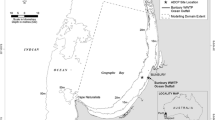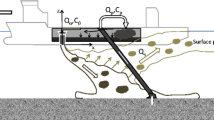Abstract
This study aims at evaluating two numerical methods for 3D simulation of marine pollutant dispersion problems: the random walk particle tracking (RWPT) method and an explicit second-order finite difference method (FDM) for assessing produced water discharges from offshore oil platform. Test cases in a steady flow field were used to evaluate the efficiency and accuracy of simulating pollutant concentration profiles obtained using both the FDM and RWPT method in comparison with an analytical solution. Additionally, a field study was conducted to simulate the lead concentration distribution of produced water discharged from an oil platform off Canada’s east coast, based on the Princeton Ocean Model modeling the ocean flow in the study area with field verifications. Results indicate that, with proper configuration of grid resolution and particle resolution, both FDM and RWPT method can provide accurate results with reasonable computational costs for complex field cases. Particularly, the satisfactory 3D simulations of marine pollutant dispersion in the far field by both FDM and RWPT numerical methods enable effective assessment and management of offshore waste discharges.






Similar content being viewed by others
References
Abbaspour, M., Javid, A. H., Moghimi, P., & Kayhan, K. (2005). Modeling of thermal pollution in coastal area and its economical and environmental assessment. International Journal of Environmental Science and Technology, 2, 13–26.
Ahmad, Z., Kothyari, U. C., & Ranga Raju, K. G. (1999). Finite difference scheme for longitudinal dispersion in open channels. Journal of Hydraulic Research, 37, 389–406.
Anfossi, D., Tinarelli, G., Castelli, S. T., Nibart, M., Olry, C., & Commanay, J. (2010). A new Lagrangian particle model for the simulation of dense gas dispersion. Atmospheric Environment, 44, 753–762.
Argall, R., Sanders, B. F., & Poon, Y. K. (2003). Random-walk suspended sediment transport and settling model. In M. L. Spaulding (Ed.), Proceedings of the Eighth International Conference: Estuarine and Coastal Modeling (pp. 713–730). Monterey: American Society of Civil Engineers (ASCE).
Asselin, R. (1972). Frequency filters for time integrations. Monthly Weather Review, 100, 487–490.
Baetsle, L. H. (1969). Migration of radionuclides in porous media. In A. M. F. Duhamel (Ed.), Progress in Nuclear Energy, Series XII, Health Physics (pp. 707–730). Elmsford: Pergamon Press.
Bagtzoglou, A. C., Tompson, A. F. B., & Dougherty, D. E. (1992). Project functions for particle-grid methods. Numerical Methods for Partial Differential Equations, 8, 325–340.
Banton, O., Porel, G., & Delay, F. (1997). Coupling of the time domain random walk method with the finite fragment method to simulate flow and transport in 1-D heterogeneous media. Journal of Hydrology (Amsterdam, Neth.), 201, 49–61.
Berloff, P. S., & McWilliams, J. C. (2002). Material transport in oceanic gyres. Part II: hierarchy of stochastic models. Journal of Physical Oceanography, 32, 797–830.
CAPP. (2001). Offshore produced water waste management. Technical Report 2001–0030, Calgary, AB, Halifax, NS, St. John’s, NL: Canadian Association of Petroleum Producers (CAPP).
Chen, Z., Zhao, L., Lee, K., & Hannath, C. (2007). Modeling and assessment of the produced water discharges from offshore petroleum platforms. Water Quality Research Journal of Canada, 42, 303–310.
Chung, T. J. (2002). Computational fluid dynamics. Cambridge: Cambridge University Press.
Courant, R., Friedrichs, K., & Lewy, H. (1967). On the partial difference equations of mathematical physics. IBM Journal, English translation of the 1928 German original, 215–234.
Date, A. W. (2005). Introduction to computational fluid dynamics. Cambridge: Cambridge University Press.
Domenico, P. A., & Robbins, G. A. (1985). A new method of contaminant plume analysis. Ground Water, 23, 476–485.
Du, S. (2001). A heuristic Lagrangian stochastic particle model of relative diffusion: model formulation and preliminary results. Atmospheric Environment, 35, 1597–1607.
Durran, D. R. (1991). The third-order Adams-Bashforth method: an attractive alternative to leapfrog time differencing. Monthly Weather Review, 119, 702–720.
Glass, J., & Rodi, W. (1982). A higher order numerical scheme for scalar transport. Computer Methods in Applied Mechanics and Engineering, 31, 337–358.
Guyonnet, D., & Neville, C. (2004). Dimensionless analysis of two analytical solutions for 3-D solute transport in groundwater. Journal of Contaminant Hydrology, 75, 141–153.
Hao, X., & Varshney, A. (2006). Geometry-guided computation of 3D electrostatics for large molecular datasets. Computer Aided Geometric Design, 23, 545–557.
Hunt, B. (1978). Dispersive sources in uniform groundwater flow. Journal of the Hydraulics Division American Society of Civil Engineers, 104, 75–85.
Hunter, J. R., Craig, P. D., & Phillips, H. E. (1993). On the use of random walk models with spatially variable diffusivity. Journal of Computational Physics, 106, 366–376.
Hurley, P., & Physick, W. (1993). Lagrangian particle modeling of buoyant point sources plume rise and entrapment under convective conditions. Atmospheric Environment, 27A, 1579–1584.
Israelsson, P. H., Kim, Y. D., & Adams, E. E. (2006). A comparison of three Lagrangian approaches for extending near field mixing calculations. Environmental Modelling & Software, 21, 1631–1649.
JWSL. (2007). Hibernia production phase environmental effects monitorng program—year six (2007) volume I—interpretation. Jacques Whitford Stantec Limited, St. John’s NL, pages 63
Kowalick, Z., & Murty, T. S. (1993). Numerical modeling of ocean dynamics. Advanced series on ocean engineering—volume 5. Singapore: World Scientific.
Lee, K., Azetsu-Scott, K., Cobanli, S. E., Dalziel, J., Niven, S., Wohlgeschaffen, G., & Yeats, P. (2005). Overview of potential impacts from produced water discharges in Atlantic Canada. In S. L. Armsworthy, P. J. Cranford, & K. Lee (Eds.), Offshore oil and gas environmental effects monitoring approaches and technologies (pp. 319–342). Ohio: Battelle Press.
Lewis, R. E. (1997). Dispersion in estuaries and coastal waters. Chichester: Wiley.
Li, S., & Hodgins, D. O. (2004). A dynamically coupled outfall plume-circulation model for effluent dispersion in Burrard Inlet, British Columbia. Journal of Environmental Engineering and Science, 3, 433–449.
Luhar, A. K., & Britter, R. E. (1992). Random-walk modeling of buoyant-plume dispersion in the convective boundary layer. Atmospheric Environment, 26A, 1283–1298.
Martin, J. L., & McCutcheon, S. C. (1998). Hydrodynamics and transport for water quality modeling. New York: Lewis Publishers.
Mellor, G.L. (2004). Users guide for a three-dimensional, primitive equation, numerical ocean model. Princeton, NJ: Princeton University. http://www.aos.princeton.edu/WWWPUBLIC/htdocs.pom/FTPbackup/usersguide0604.pdf. Accessed 22 Mar 2012.
Mellor, G. L., Ezer, T., & Oey, L.-Y. (1994). The pressure gradient conundrum of sigma coordinate ocean models. Journal of Atmospheric and Oceanic Technology, 11, 1126–1134.
Mellor, G. L., Oey, L.-Y., & Ezer, T. (1998). Sigma coordinate pressure gradient errors and the seamount problem. Journal of Atmospheric and Oceanic Technology, 15, 1122–1131.
Moeller, J. C., & Adams, E. E. (1993). Comparison of Eulerian–Lagrangian, random walk and hybrid methods of modeling pollutant transport. In M. L. Spaulding, A. Blumberg, R. Cheng, & C. Swanson (Eds.), Proceedings of the 3rd International Conference: Estuarine and Coastal Modeling (pp. 609–623). Oak Brook: American Society of Civil Engineers (ASCE).
Nakano, M., & Povinec, P. P. (2003). Oceanic general circulation model for the assessment of the distribution of 137Cs in the world ocean. Deep-Sea Research Part II, 50, 2803–2816.
PAL Environmental Services. (2005). Hibernia annual environmental data summary. Report Prepared for Exxon Mobil, Newfoundland, CA.
Periáñez, R. (2006). Modeling surface radioactive spill dispersion in the Alboran Sea. Journal of Environmental Radioactivity, 90, 48–67.
Periáñez, R., & Elliott, A. J. (2002). A particle-tracking method for simulating the dispersion of non-conservative radionuclides in coastal waters. Journal of Environmental Radioactivity, 58, 13–33.
Rao, K. R., Nehrbass, J., & Lee, R. (1999). Discretization errors in finite methods: issues and possible solutions. Computer Methods in Applied Mechanics and Engineering, 169, 219–236.
Riddle, A. M., Beling, E. M., & Murray-Smith, R. J. (2001). Modeling the uncertainties in predicting produced water concentrations in the North Sea. Environmental Modelling & Software, 16, 659–668.
Ross, O. N., & Sharples, J. (2004). Recipe for 1-D Lagrangian particle tracking models in space-varying diffusivity. Limnology and Oceanography: Methods, 2, 289–302.
Salamon, P., Fernandez-Garcia, D., & Gomez-Hernandez, J. J. (2006). A review and numerical assessment of the random walk particle tracking method. Journal of Contaminant Hydrology, 87, 277–305.
Srinivasan, V., Clement, T. P., & Lee, K. K. (2007). Domenico solution—is it valid? Ground Water, 45, 136–146.
Suh, S. W. (1987). A hybrid approach to particle tracking and Eulerian–Lagrangian models in the simulation of coastal dispersion. Environmental Modelling & Software, 21, 234–242.
Thomson, D. J. (1987). Criteria for the selection of stochastic models of particle trajectories in turbulent flows. Journal of Fluid Mechanics, 180, 529–556.
Thomson, D. J. (1990). A stochastic model for the motion of particle pairs in isotropic high-Reynolds-number turbulence, and its application to the problem of concentration variance. Journal of Fluid Mechanics, 210, 113–153.
Visser, A. W. (1997). Using random walk models to simulate the vertical distribution of particles in a turbulent water column. Marine Ecology Progress Series, 158, 275–281.
Wendt, J. F. (2009). Computational fluid dynamics: an introduction. Berlin: Springer.
West, M., & Kueper, B.H. (2004). Natural attenuation of solute plumes in bedded fractured rock. Proceedings of USEPA/NGWA Fractured Rock Conference, Portland, Maine, National Ground Water Association, pp. 388–401.
West, M. R., Kueper, B. H., & Ungs, M. J. (2007). On the use and error of approximation in the Domenico (1987) solution. Ground Water, 45, 126–135.
Westerink, J. J., & Shea, D. (1989). Consistent higher degree Petrov-Galerkin methods for the solution of the transient convection–diffusion equation. International Journal for Numerical Methods in Engineering, 28, 1077–1101.
Zhao, L., Chen, Z., & Lee, K. (2011). Modelling the dispersion of wastewater discharges from offshore outfalls: a review. Environmental Reviews, 19, 107–120.
Acknowledgments
This research was funded in part by the Natural Science and Engineering Research Council Canada (NSERC). The authors wish to thank the anonymous reviewers especially the reviewer 2 for their helpful comments.
Author information
Authors and Affiliations
Corresponding author
Rights and permissions
About this article
Cite this article
Zhao, L., Chen, Z. & Lee, K. Evaluation of Numerical Modeling Methods for the Management of Produced Water Discharges in the Coastal Region with a Canadian Case Study. Environ Model Assess 19, 57–70 (2014). https://doi.org/10.1007/s10666-013-9383-1
Received:
Accepted:
Published:
Issue Date:
DOI: https://doi.org/10.1007/s10666-013-9383-1




